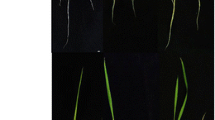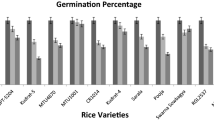Abstract
The understanding of physio-biochemical and molecular attributes along with morphological traits contributing to the salinity tolerance is important for developing salt-tolerant rice (Oryza sativa L.) varieties. To explore these facts, rice genotypes CSR10 and MI48 with contrasting salt tolerance were characterized under salt stress (control, 75 and 150 mM NaCl) conditions. CSR10 expressed higher rate of physio-biochemical parameters, maintained lower Na/K ratio in shoots, and restricted Na translocation from roots to shoots than MI48. The higher expression of genes related to the osmotic module (DREB2A and LEA3) and ionic module (HKT2;1 and SOS1) in roots of CSR10 suppresses the stress, enhances electrolyte leakage, promotes the higher compatible solute accumulation, and maintains cellular ionic homeostasis leading to better salt stress tolerance than MI48. This study further adds on the importance of these genes in salt tolerance by comparing their behaviour in contrasting rice genotypes and utilizing specific marker to identify salinity-tolerant accessions/donors among germplasm; overexpression of these genes which accelerate the selection procedure precisely has been shown.







Similar content being viewed by others
Abbreviations
- ROS:
-
Reactive oxygen species
- LEA:
-
Late embryogenesis abundant
- HKT:
-
High-affinity K+ transporter
- NHX:
-
Vacuolar Na+/H+ antiporter
- DREB:
-
Dehydration-responsive element-binding protein
- SOS:
-
Salt overly sensitive
- CATA:
-
Catalase
- POX:
-
Peroxidase
- RWC:
-
Relative water content
- DAB:
-
3,3′-Diaminobenzidine
- FW:
-
Fresh weight
- DW:
-
Dry weight
References
Annunziata MG, Ciarmiello LF, Woodrow P, Maximova E, Fuggi A, Carillo P (2017) Durum wheat roots adapt to salinity remodeling the cellular content of nitrogen metabolites and sucrose. Front Plant Sci 7:2035
Arnon DI (1949) Copper enzymes in intact chloroplast. Polyphenoxidase in Beta vulgaris. Plant Physiol 24:1–15
Ashraf M, Foolad MA (2007) Improving plant abiotic-stress resistance by exogenous application of osmoprotectants glycine betaine and proline. Environ Exp Bot 59:206–216
Bates LS, Waklren RP (1973) Rapid determination of free proline for water stress studies. Plant Soil 39:205–207
Bharathkumar S, Jena PP, Kumar J, Baksh SKY, Samal R, Gouda G, Mukherjee M, Donde R, Vijayan J, Parida M, Reddy JN (2016) Identification of new alleles in salt tolerant rice germplasm lines through phenotypic and genotypic screening. Int J Agric Biol 18:441–448
Cai W, Liu W, Wang WS, Fu ZW, Han TT, Lu YT (2015) Overexpression of rat neurons nitric oxide synthase in rice enhances drought and salt tolerance. PLoS One 10:e0131599
Carillo P (2018) GABA shunt in durum wheat. Front Plant Sci 9:100
Carillo P, Mastrolonardo G, Nacca F, Parisi D, Verlotta A, Fuggi A (2008) Nitrogen metabolism in durum wheat under salinity: accumulation of proline and glycine betaine. Funct Plant Biol 35:412–426
Carillo P, Annunziata MG, Pontecorvo G, Fuggi A, Woodrow P (2011) Salinity stress and salt tolerance. In: Shanker A, Venkateswarlu B (eds) Abiotic stress in plants–mechanisms and adaptations. InTech, Croatia, pp 21–38
Chen Z, Cuin TA, Zhou M, Twomey A, Naidu BP (2007) Compatible solute accumulation and stress-mitigating effects in barley genotypes contrasting in their salt tolerance. J Exp Bot 58(15–16):4245–4255
Chen JQ, Meng XP, Zhang Y, Xia M, Wang XP (2008) Overexpression of OsDREB genes lead to enhanced drought tolerance in rice. Biotechnol Lett 30:2191–2198
Chunthaburee S, Dongsansuk A, Sanitchon J, Pattanagul W, Theerakulpisut P (2016) Physiological and biochemical parameters for evaluation and clustering of rice cultivars differing in salt tolerance at seedling stage. Saudi J Biol Sci 23:467–477
Darwish E, Testerink C, Khalil M, El-Shihy O, Munnik T (2009) Phospholipid signalling responses in salt-stressed rice leaves. Plant Cell Physiol 50(5):986–997
Deinlein U, Stephan AB, Horie T, Luo W, Xu G, Schroeder JI (2014) Plant salt-tolerance mechanisms. Trends Plant Sci 19:371–379
Djanaguiraman M, Prasad PV, Seppanen M (2010) Selenium protects sorghum leaves from oxidative damage under high temperature stress by enhancing antioxidant defense system. Plant Physiol Biochem 48(12):999–1007
El-Bassiouny HMS, Bekheta MA (2005) Effect of salt stress on relative water content, lipid peroxidation, polyamines, amino acids and ethylene of two wheat cultivars. Int J Agric Biol 7(3):363–368
Fageria NK, Stone LF, Santos ABD (2012) Breeding for salinity tolerance. In: Fritsche-Neto R, Borém A (eds) Plant breeding for abiotic stress tolerance. Springer-Verlag, Berlin, pp 103–122
Fukuda A, Nakamura A, Tagiri A, Tanaka H, Miyao A, Hirochika H, Tanaka Y (2004) Function, intracellular localization and the importance in salt tolerance of a vacuolar Na+/H+ antiporter from rice. Plant Cell Physiol 45(2):146–159
Ghars MA, Parre E, Debez A, Bordenave M, Richard L (2008) Comparative salt tolerance analysis between Arabidopsis thaliana and Thellungiella halophila, with special emphasis on K+/Na+ selectivity and proline accumulation. J Plant Physiol 165:588–599
Gong HJ, Randall DP, Flowers TJ (2006) Silicon deposition in the root reduces sodium uptake in rice (Oryza sativa L.) seedlings by reducing bypass flow. Plant Cell Environ 29:1970–1979
Hare PD, Cress WA (1997) Metabolic implications of stress-induced proline accumulation in plants. Plant Growth Regul 21:79–102
Hasegawa PM (2013) Sodium (Na+) homeostasis and salt tolerance of plants. Environ Exp Bot 92:19–31
Hauser F, Horie T (2010) A conserved primary salt tolerance mechanism mediated by HKT transporters: a mechanism for sodium exclusion and maintenance of high K+/Na+ ratio in leaves during salinity stress. Plant Cell Environ 33:552–565
Hirayama T, Shinozaki K (2010) Research on plant abiotic stress responses in the post-genome era: past, present and future. Plant J 61:1041–1052
Hoai NTT, Shim IS, Kobayashi K, Kenji U (2003) Accumulation of some nitrogen compounds in response to salt stress and their relationships with salt tolerance in rice (Oryza sativa L.) seedlings. Plant Growth Regul 41:159–164
Horie T, Costa A, Kim TH, Han MJ, Horie R, Leung HY, Miyao A, Hirochika H, An G, Schroeder JI (2007) Rice OsHKT2;1 transporter mediates large Na+ influx component into K+-starved roots for growth. EMBO J 26:3003–3014
Jamil M, Lee DB, Jung KY, Ashraf M, Lee SC, Rhal ES (2006) Effect of salt (NaCl) stress on germination and early seedling growth of four vegetables species. J Cent Eur Agric 7:273–282
Joseph B, Jini D, Sujatha S (2010) Biological and physiological perspectives of specificity in abiotic salt stress response from various rice plants. Asian J Agric Sci 2:99–105
Krishnamurthy P, Ranathunge R, Nayak S, Schreiber L, Mathew MK (2011) Root barriers block Na+ traffic to shoots in rice (Oryza sativa L.). J Exp Bot 62:4215–4228
Lawlor D (2013) Genetic engineering to improve plant performance under drought. J Exp Bot 64:83–108
Li Z, Yu J, Peng Y, Huang B (2016) Metabolic pathways regulated by γ-aminobutyric acid (GABA) contributing to heat tolerance in creeping bentgrass (Agrostis stolonifera). Sci Rep 6:30338
Liao YD, Lin KH, Chen CC (2016) Oryza sativa protein phosphatase 1a (OsPP1a) involved in salt stress tolerance in transgenic rice. Mol Breed 36:22
Liu Q, Kasuga M, Sakuma Y, Abe H, Miura S, Yamaguchi-Shinozaki K, Shinozaki K (1998) Two transcription factors, DREB1 and DREB2, with an EREBP/AP2 DNA binding domain separate two cellular signal transduction pathways in drought-and low-temperature-responsive gene expression, respectively, in Arabidopsis. Plant Cell 10:1391–1406
Mallikarjuna G, Mallikarjuna K, Reddy MK, Kaul T (2011) Expression of OsDREB2A transcription factor confers enhanced dehydration and salt stress tolerance in rice (Oryza sativa L.). Biotechnol Lett 33:1689–1697
Martinez-Atienza J, Jiang X, Garciadeblas B, Mendoza I, Zhu JK, Pardo JM (2007) Conservation of the salt overly sensitive pathway in rice. Plant Physiol 143:1001–1012
Matsukura S, Mizoi J, Yoshida T, Todaka D, Ito Y, Maruyama K, Shinozaki K, Yamaguchi-Shinozaki K (2010) Comprehensive analysis of rice DREB2-type genes that encode transcription factors involved in the expression of abiotic stress-responsive genes. Mol Gen Genomics 283:185–196
Mishra P, Bhoomika K, Dubey RS (2011) Differential responses of antioxidative defense system to prolonged salinity stress in salt-tolerant and salt-sensitive Indica rice (Oryza sativa L.) seedlings. Protoplasma 250:3–19
Munns R, Tester M (2008) Mechanisms of salinity tolerance. Annu Rev Plant Biol 59:651–681
Munns R, James RA, Xu B, Athman A, Conn SJ, Jordans C, Byrt CS, Hare RA, Tyerman SD, Tester M (2012) Wheat grain yield on saline soils is improved by an ancestral Na+ transporter gene. Nat Biotechnol 30:360–364
Nawaz K, Talat AI, Hussain K, Majeed A (2010) Induction of salt tolerance in two cultivars of sorghum (Sorghum bicolor L.) by exogenous application of proline at seedling stage. World Appl Sci J 10:93–99
Negrão S, Schmöckel SM, Tester M (2017) Evaluating physiological responses of plants to salinity stress. Ann Bot 119:1–11
Oh SJ, Kim YS, Kwon CW, Park HK, Jeong JS, Kim JK (2009) Overexpression of the transcription factor AP37 in rice improves grain yield under drought conditions. Plant Physiol 150:1368–1379
Pandit A, Rai V, Sharma TR, Sharma PC, Singh NK (2011) Differentially expressed genes in sensitive and tolerant rice varieties in response to salt stress. J Plant Biochem Biotechnol 20:149–154
Passaia G, Spagnolo FL, Caverzan A, Jardim-Messeder D, Christoff AP, Gaeta ML, de Araujo Mariath JE, Margis R, Margis-Pinheiro M (2013) The mitochondrial glutathione peroxidase GPX3 is essential for H2O2 homeostasis and root and shoot development in rice. Plant Sci 208:93–101
Premachandra GS, Saneoka H, Ogata S (1990) Cell membrane stability an indicator of drought tolerance as affected by applied N in soybean. J Agric Sci 115:63–66
Shi H, Quintero FJ, Pardo JM, Zhu JK (2002) The putative plasma membrane Na+/H+ antiporter SOS1 controls long-distance Na+ transport in plants. Plant Cell 14:465–477
Singh J, Singh V, Sharma PC (2018) Elucidating the role of osmotic, ionic and major salt responsive transcript components towards salinity tolerance in contrasting chickpea (Cicer arietinum L.) genotypes. Physiol Mol Biol Plants 24(3):441–453. https://doi.org/10.1007/s12298-018-0517-4
Thordal-Christensen H, Zhang Z, Wei Y, Collinge DB (1997) Subcellular localization of H2O2 in plants, H2O2 accumulation in papillae and hypersensitive response during barley-powdery mildew interaction. Plant J 11:1187–1194
Turhan H, Genc L, Smith SE, Bostanci YB, Turkmen OS (2008) Assessment of the effect of salinity on the early growth stage of the common sunflower using spectral discrimination techniques. Afr J Biotechnol 7(6):750–756
Wang H, Zhang M, Guo R, Shi D, Liu B, Lin X, Yang C (2012) Effects of salt stress on ion balance and nitrogen metabolism of old and young leaves in rice (Oryza sativa L.). BMC Plant Biol 12:194
Wang R, Jing W, Xiao L, Jin Y, Shen L, Zhang W (2015) The rice high-affinity potassium transporter1;1 is involved in salt tolerance and regulated by an MYB-type transcription factor. Plant Physiol 168:1076–1090
Widodo JHP, Newbigin E, Tester M, Bacic A (2009) Metabolic responses to salt stress of barley (Hordeum vulgare L.) cultivars, Sahara and Clipper, which differ in salt tolerance. J Exp Bot 60:4089–4103
Woodrow P, Ciarmiello L, Annunziata MG, Pacifico S, Iannuzzi F, Mirto A, D’Amelia L, Dell’Aversana E, Piccolella S, Fuggi A, Carillo P (2017) Durum wheat seedling responses to simultaneous high light and salinity involve a fine reconfiguration of amino acids and carbohydrate metabolism. Physiol Plant 159(3):290–312
Wu D, Cai S, Chen M, Ye L, Chen Z, Zhang H (2013) Tissue metabolic responses to salt stress in wild and cultivated barley. PLoS One 8:e55431
Yang Q, Chen ZZ, Zhou XF, Yin HB, Li X, Xin XF, Hong XH, Zhu JK, Gong Z (2009) Overexpression of SOS (salt overly sensitive) genes increases salt tolerance in transgenic Arabidopsis. Mol Plant 2:22–31
Yoshida S, Forno DA, Cock JH, Gomez KA (1976) Laboratory manual for physiological studies of rice. International Rice Research Institute, Laos Banos
Author information
Authors and Affiliations
Corresponding author
Ethics declarations
Conflict of interest
The authors declare that they have no conflict of interest.
Additional information
Handling Editor: Néstor Carrillo
Electronic supplementary material
ESM 1
(DOCX 38 kb)
Rights and permissions
About this article
Cite this article
Singh, V., Singh, A.P., Bhadoria, J. et al. Differential expression of salt-responsive genes to salinity stress in salt-tolerant and salt-sensitive rice (Oryza sativa L.) at seedling stage. Protoplasma 255, 1667–1681 (2018). https://doi.org/10.1007/s00709-018-1257-6
Received:
Accepted:
Published:
Issue Date:
DOI: https://doi.org/10.1007/s00709-018-1257-6




